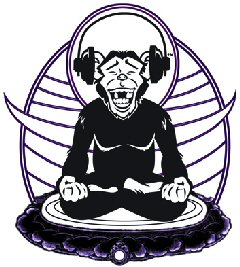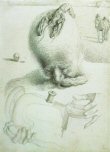Apart from human beings, only a few animals have the physical characteristics and mental capacities for using a tool. Monkeys are among them. But in what way do the primates learn to use a tool?
Research by Giacomo Rizzolatti of the University of Parma tells us that the brain uses the trick of considering the tool as a part of the body. Some previous researchers demonstrated that the hand movements are controlled by the area of the brain called F5.
He registered the cerebral activity of two macaques after they had learned to grasp food with pliers. He documented the activity in the F5 area and in the area called F1, which in turn was employed in the manipulation of objects. He discovered that there was the same cerebral activity both when the monkeys grasped the food with only the help of their own hand and with the pliers: the neuronal activity is transferred from the hands to the tool, as if the tool were the hand and its extremity were the fingers.
Furthermore, Rizzolatti puts in evidence the fact that the F5 area is rich with mirror neurons, a type of neurons that he had previously discovered, which are excited both when an act is being performed and when another individual is observed while performing the same act. The discoveries, according to Dietrich Stout, an archeologist specializing in the use of tools, tell us that “obviously, the use of instruments by the monkeys implies an incorporation of the instruments in the body scheme, literally it is an extension of a body”.
The monkey cannot distinguish between his own hands and the tool that he uses, considering the latter a real extension of his body. It reminds me of what Marshall McLuhan said regarding the media and tools as extensions of ourselves.
In this experiment, however, they make a decision without consulting the person in-charge. The factor of consciousness is missing, which is still elusive to neuroscience. The presence or otherwise of consciousness and what it is about cannot be identified by experiments. This experiment made me reflect on the relationship between consciousness, tools, and the spiritual paths toward awareness.
Therefore, tools are really like body extensions on a neural level, but the consciousness of a human being allows the understanding that the tool is external. The monkey does not know the duality which is produced by the self-consciousness, thus it seems like getting closer to a spiritual condition of a “union with everything.” However, the union takes place on a pre-conscious level.
The consciousness of ourselves is at the same time joy and distress since they entrap us in the mind, separating us from the rest of existence, and it splits as well on the inner level down to our inside, but it also allows us to reach spiritual peaks unknown to our hungry macaque. Self-consciousness and consequently the development of an ego which separates us from everything are the intermediate phases between the monkey and the spiritually enlightened state.
[/en][it]
A parte l’uomo, solo pochissimi animali hanno le caratteristiche fisiche e le capacità mentali per utilizzare uno strumento. Tra questi, le scimmie. Ma come fanno i primati ad apprendere l’uso di uno strumento?
Uno studio di Giacomo Rizzolatti dell’università di Parma ci dice che il cervello usa il trucco di considerare lo strumento come fosse parte del proprio corpo. Alcune ricerche precedenti avevano mostrato che le azioni della mano vengono controllare da un’area del cervello chiamata F5.
Egli ed il suo team hanno registrato l’attività cerebrale di due macachi dopo che avevano appreso ad afferrare il cibo con delle pinze. Hanno documentato l’attività nell’area F5 e in un’area chiamata F1 che a sua volta è implicata nella manipolazione di oggetti. Hanno scoperto che vi era la stessa attività cerebrale sia quando le scimmie afferravano il cibo con l’ausilio delle sole mani che quando usavano le pinze: l’attività neuronale viene trasferita dalle mani allo strumento, come se lo strumento fosse la mano e la sua estremità fossero le dita.
Inoltre Rizzolatti mette in evidenza il fatto che l’area F5 è ricca di neuroni specchio, un tipo di neurone da lui scoperto in precedenza, che si eccitano sia quando si svolge un’azione sia quando si osserva un altro individuo che attua la stessa cosa. Le scoperte, secondo Dietrich Stout, un archeologo specializzato nell’uso di strumenti ci dicono che “chiaramente, l’uso degli strumenti da parte delle scimmie implica l’incorporazione degli strumenti nello schema corporeo, letteralmente una estensione del corpo”.
La scimmia non sa distinguere tra le proprie mani e lo strumento che utilizza, considerando quest’ultimo come una vera e propria estensione del corpo. Questo mi ricorda ciò che disse Marshall McLuhan a riguardo dei media e degli strumenti come estensioni di noi stessi.
In questo esperimento tuttavia si fanno i conti senza l’oste. Manca il fattore coscienza, che tutt’ora sfugge alle neuroscienze. La presenza o meno della coscienza e di cosa si tratta non può essere rilevata dagli esperimenti. Questo esperimento mi ha fatto riflettere sul rapporto tra coscienza, strumenti e percorsi di ricerca spirituali verso la consapevolezza.
A un livello neurale primitivo quindi gli strumenti sono veramente estensioni del corpo, ma la consapevolezza di un essere umano permette di comprendere che lo strumento è esterno a noi. La scimmia non conosce la dualità che viene prodotta dalla coscienza di sé, quindi sembrerebbe avvicinarsi ad una condizione spirituale di “unione con il tutto” . L’unione però avviene ad un livello pre-cosciente.
La coscienza di se stessi è allo stesso tempo gioia e dolore poiché ci intrappola nella mente, separandoci dal resto dell’esistenza, e ci scinde anche al nostro interno, ma, anche, ci consente di raggiungere vette spirituali ignote al nostro famelico macaco. La coscienza di sé e di conseguenza lo sviluppo di un ego che ci separa dal tutto sono fasi intermedie tra la scimmia e lo stato di illuminazione spirituale.
[/it]
Leggi tutto “The monkey and the Buddha”



